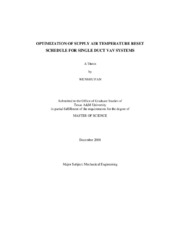| dc.description.abstract | In a single duct variable air volume (SDVAV) system, the supply air
temperature is usually set as a constant value. Since this constant setpoint is selected
to satisfy the maximum cooling load conditions, significant reheat will occur once the
airflow reaches the minimum and the heating load increases. Resetting the supply air
temperature (SAT) higher during the heating season can reduce the reheat. However,
air flow will increase when the SAT is higher which consume extra fan power.
Therefore, to minimize the total operating cost of a SDVAV system, the supply air
temperature is typically reset based on outside air temperature (OAT) with a linear
reset schedule. However, the linear reset schedule is often determined based on the
engineer’s experience and it may not represent the optimal reset schedule for each
building.
This thesis documents a study to determine the optimized supply air
temperature reset schedule for SDVAV systems and analyzes the influencing factors
under different operation scenarios. The study was divided into five main sections. The
first section introduces the research background and objective. Literature review is
documented after the introduction. The third section describes the methodology used
in this study and the fourth section develops an in-depth discussion and analysis of the impact of the key influencing factors: minimum air flow ratio; ratio of exterior zone
area to total floor area (i.e., exterior area ratio); internal load and the prices of the
electricity; the cooling and the heating energy. The simulation results using EnergyPlus
Version 2.1.0 for various operation scenarios are investigated in this section. The last
section is a conclusion of the whole study.
The optimized supply air temperature can be set with respect to the OAT. The
study found that instead of a simple linear relationship, the optimal reset schedule has
several distinctive segments. Moreover, it is found that the optimal supply air
temperature reset schedule should be modified with the change of operation conditions
(e.g., different minimum flow ratios and internal loads). Minimum air flow ratio has a
significant impact on energy consumption in a SDVAV system. Exterior area ratio
determines zone load distribution and will change system load indirectly. For buildings
with small internal load, a more aggressive supply air temperature reset tactic can be
implemented. In addition, the cost of electricity, cooling and heating energy can
determine which end use energy (i.e., reheat energy and fan power) should take the
priority. | en |


